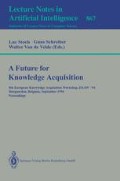Abstract
The SBF (Spark, Burn, Firefighter) project began five years ago. Its goal was to develop a framework for making it easier to evolve effective application programs. Its approach was to provide an integrated set of tools to help developers create applications by configuring and customizing reusable software components, called mechanisms. SBF aimed to be usable by both programmers and non-programmers. SBF has undergone major changes several times, motivated by user feedback and data collected in usability studies. The emphasis has shifted from understanding how applications can be built to understanding what assistance is needed in a workplace and how some automation might best be introduced into an integrated workplace. This paper describes how SBF has evolved over the years, and, more importantly, what motivated the major changes.
Preview
Unable to display preview. Download preview PDF.
References
Barker, V.E., O'Connor, D.E., Bachant, J., and Soloway, E. (1989). Expert systems for configuration at Digital: XCON and beyond. Communications of the ACM, 32(3), 298–317.
Birmingham, W.P. and Siewiorek, D. (1989). Automated knowledge acquisition for a computer hardware synthesis system. Knowledge Acquisition, 1(4), 321–340.
Chandrasekaran, B. (1986). Generic tasks in knowledge-based reasoning: High-level building blocks for expert system design. IEEE Expert, 1, 23–30.
Chandrasekaran, B. and Johnson, T.R. (1993). Generic tasks and task structures: History, critique and new directions. In David, J.M., Krivine, J.P. and Simmons, R. (Eds.), Second Generation Expert Systems. Berlin: Springer-Verlag.
Dallemagne, G., Klinker, G., Marques, D., McDermott, J. and Tung, D. (1992). Making application programming more worthwhile. In Schmalhofer, F. and Strube, G. (Eds.), Knowledge Engineering and Cognition. Berlin: Springer-Verlag.
Eshelman, L., Ehret, D., McDermott, J., and Tan, M. (1988). MOLE: A tenacious knowledge-acquisition tool. In Boose, J. and Gaines, B. (Eds.), Knowledge Acquisition Tools for Expert Systems. San Diego, CA: Academic Press.
Klinker, G. (1988). KNACK: Sample-driven knowledge acquisition for reporting systems. In Marcus, S. (Ed.), Automating Knowledge Acquisition for Expert Systems. Boston, MA: Kluwer Academic Publishers.
Klinker, G., Boyd, C., Dong, D., Maiman, J., McDermott, J. and Schnelbach, R. (1989). Building expert systems with KNACK. Knowledge Acquisition, 1, 299–320.
Klinker, G., Bhola, C., Dallemagne, G., Marques, D. and McDermott, J. (1991). Usable and reusable programming constructs. Knowledge Acquisition, 3, 117–135.
Klinker, G., Linster, M., Marques, D., McDermott, J. and Yost, G. (1994). Exploiting problem descriptions to provide assistance with the Sisyphus task. International Journal of Human-Computer Systems, 40(2).
Klinker, G., Marques, D., and McDermott, J. (1993). The Active Glossary: Taking integration seriously. Knowledge Acquisition, 5, 173–197.
Leonard-Barton, D. (Fall 1987). The case for integrative innovation: An expert system at Digital. Sloan Management Review.
Linster, M., Klinker, G., McDermott, J. and Yost, G. (1994). Business-process modeling and information-system configuration in the SBF approach. Proceedings of the First European Conference on Cognitive Science in Industry. To appear.
Malone, T.W., Crowston, K., Lee, J., and Pentland, B. (1993). Tools for inventing organizations: Toward a handbook of organizational processes. (Tech. Rep. CCS WP #141, Sloan School WP #3562-93). Center for Coordination Science, Sloan School of Management, MIT.
Marcus, S. (1988). Taking backtracking with a grain of SALT. In Boose, J. and Gaines, B. (Eds.), Knowledge Acquisition Tools for Expert Systems. San Diego, CA: Academic Press.
Marcus, S., McDermott, J. and Wang, T. (1985). Knowledge acquisition for constructive systems. Proceedings of the Ninth International Joint Conference on Artificial Intelligence.
Marques, D., Klinker, G., Dallemagne, G., Gautier, P., McDermott, J., and Tung, D. (1991). More data on usable and reusable programming constructs. Proceedings of the 6th Banff Knowledge Acquisition for Knowledge-Based Systems Workshop. Banff, Alberta, Canada.
Marques, D., Dallemagne, G., Klinker, G., McDermott, J., and Tung, D. (1992). Easy programming: Empowering people to build their own applications. IEEE Expert, 7(3), 16–29.
McDermott, J. (1988). Preliminary steps toward a taxonomy of problem-solving methods. In Marcus, S. (Ed.), Automating Knowledge Acquisition for Expert Systems. Boston, MA: Kluwer Academic Publishers.
Musen, M.A., Fagan, L.M., Combs, D.M. and Shortliffe, E.H. (1988). Use of a domain model to drive an interactive knowledge-editing tool. In Boose, J. and Gaines, B. (Eds.), Knowledge Acquisition Tools for Expert Systems. San Diego, CA: Academic Press.
Musen, M.A. and van der Lei, J. (1988). Of brittleness and bottlenecks: Challenges in the construction of expert-system and pattern-recognition models. In Gelsema, E.S. and Kanal, L. (Eds.), Pattern Recognition and Artificial Intelligence: Towards an Integration. New York: Elsevier.
Newell, A. (1982). The knowledge level. Artificial Intelligence, 18(1), 87–121.
Puerta, A.R., Egar, J.W., Tu, S.W., and Musen, M.A. (1992). A multiple-method knowledge acquisition shell for the automatic generation of knowledge-acquisition tools. Knowledge Acquisition, 4, 171–196.
Runkel, J.T. and Birmingham, W.P. (1993). Knowledge acquisition in the small: Building knowledge-acquisition tools from pieces. Knowledge Acquisition, 5(2), 221–243.
Steels, L., and McDermott, J. (1994). The Knowledge Level in Expert Systems: Conversations and Commentary. San Diego: Academic Press.
Suchman, L. (1987). Plans and Situated Actions. Cambridge University Press.
Wenger, E. (1990). Toward a theory of cultural transparency. Doctoral dissertation, Department of Information and Computer Science, University of California, Irvine.
Yost, G.R. (1993). Acquiring knowledge in Soar. IEEE Expert, 8(3), 26–34.
Author information
Authors and Affiliations
Editor information
Rights and permissions
Copyright information
© 1994 Springer-Verlag Berlin Heidelberg
About this paper
Cite this paper
Yost, G.R., Klinker, G., Linster, M., Marques, D., McDermott, J. (1994). The SBF framework, 1989–1994: From applications to workplaces. In: Steels, L., Schreiber, G., Van de Velde, W. (eds) A Future for Knowledge Acquisition. EKAW 1994. Lecture Notes in Computer Science, vol 867. Springer, Berlin, Heidelberg. https://doi.org/10.1007/3-540-58487-0_17
Download citation
DOI: https://doi.org/10.1007/3-540-58487-0_17
Published:
Publisher Name: Springer, Berlin, Heidelberg
Print ISBN: 978-3-540-58487-2
Online ISBN: 978-3-540-49006-7
eBook Packages: Springer Book Archive

